Four Seasons Pizza Recipe calls for different toppings that correspond to the four seasons. This pizza is topped with asparagus and artichokes on one quarter of the pizza, basil, tomato, and olives on the other, mushrooms and pepper on the next quarter, and cauliflower florets on the last quarter. This recipe is based on my family’s preference for different toppings on a pizza.
Who does not love pizza? However, we all have our preferences for the choice of toppings. To satiate each one’s cravings, I decided to adapt the recipe for the Four Seasons Pizza by allocating a quarter for each of us. I love the cauliflower florets, my husband enjoys the mushroom and pepper slices, my son is fond of the asparagus and artichokes and my daughter loves the Neopolitan style. This recipe allows all of us to enjoy the toppings that we love and crave.
Origin of pizza:
What’s not to love about pizza? It is a complete meal, balancing protein, vegetables, and fat. It’s fast, cheap, and easy. As far back as the Aeneid, Aeneas and his crew used ‘thin wheaten cakes as platters for their meal’, adorned with mushrooms and herbs. Over the centuries, various forms of these flattened wheat cakes were made and consumed by seafarers and traders because they were portable, cheap, fast, and nutritious. But it wasn’t until the Neapolitans, fueled by trade and an urban migration, that the pizza began to take on what we would call today, as the mainstream acceptance. Messengers and laborers, due to their thrifty and busy lives, created the opportunity for a food that was cheap and easy to eat. The concept of the modern pizza was born.
Sold by street vendors, the pie was cut to satisfy their customer’s budget or appetite. There were famous supporters and detractors. Alexandre Dumas waxed lyrical on how the pizza was a great, inexpensive, and flavorful meal, while Samuel Morse was disgusted by this “nauseating cake …reeking of the sewer.” All that changed when on a visit to Naples, King Umberto I and Queen Margherita having been tired of the complex French cuisine, tried the pizzaiolo – Raffaele Esposito’s pizza of tomatoes, mozzarella, and basil. Uplifted by the fresh, simple, and yet flavorful ingredients, the Margherita pizza was born.
Just as it had in Naples, centuries before, it was the rapid industrialization of America that really sealed the status of the pizza. The rapid growth fueled by immigration, especially of Italians, the expansion to the west coupled with increased urbanization created demand for a quick, easy, cheap, and flavorful staple. As it spread, it changed to reflect the local needs. Thus, sprung the Chicago pizza, the Rocky Mountain Pie, and the Hawaiian. The Hawaiian in particular was invented by a Canadian of Greek ancestry. Pizza’s real explosion occurred after the 2nd World War.
But as the American pizza boomed, disposable incomes grew and with that, the demand for convenience foods, which was the gift of refrigeration. This allowed families to purchase ‘frozen’ pizzas, store them in their freezers, and bake them on demand. This changed the recipe as well. While in the past, fresh slices of tomatoes and cheese were the hallmark of the pizza, this commercialization caused the introduction of the more liquid pizza sauce, which also helped prevent the dough from drying out. The second change was the introduction of vehicles that could transport freshly cooked foods to the customer’s door.
In many ways, the pizza reflects the history of the world, evolving and changing as we progress. From the humble, hearty meal of Aeneas, through the Colombian Exchange and Italian unification, and the two World Wars, the pizza is a perennial. How many other foods can claim that same title?
Why is it called the Four Seasons Pizza?
The Four Seasons pizza is an Italian original and is called the Quattro Stagioni. It’s called so because the topping seeks to reflect the four seasons of the year. The traditional toppings reflect the produce of the seasons:
- Spring: Artichokes
- Summer: Olives
- Fall: Mushrooms
- Winter: Ham or Salami
I wanted to provide a vegetarian alternative to ham and salami, which is why I used cauliflower florets instead, to reflect a white winter. Given that I was making essentially a vegetarian pizza that was based on the concept of seasonal variability, the other change I made was to include the concept of “eating the rainbow.”
What is “eating the rainbow?”
You may ask, why I’m talking about eating the rainbow when I was highlighting the Four Seasons Pizza or the Quattro Stagioni? To be candid, I believe pizza has an unfair rap as “junk food”. I described the pizza earlier as the complete meal. If you think about the concept behind Quattro Stagioni, it reflects nature’s bounty through the seasons and every season has its own colors. Green spring, golden summers, reddish-brown for fall, and grayish white for winter. That’s a rainbow spectrum, and I wanted to reflect that in my ingredients.
Benefits of “eating the rainbow:”
The basic idea behind eating the rainbow is to eat fruits and vegetables of different colors every day. The pigments of different plants contain different phytonutrients. Therefore, each color of a vegetable used in the Four Seasons Pizza has higher levels of specific nutrients and corresponding health benefits.
- Bright Red has a higher level of lycopene (from the vitamin A family), folate, potassium, vitamins C and K1. Its health benefits include being anti-inflammatory and an antioxidant that can benefit heart health, reduce sun-related skin damage, and lower the risk of certain cancers.
- Orange and yellow contain carotenoids (such as alpha and beta carotene and beta cryptoxanthin), fiber, folate, potassium, vitamin C. Health benefits include being an anti-inflammatory and antioxidant that can benefit heart health, improve eye health, and lowering the risk of certain cancers.
- Leafy greens such as spinach contain chlorophyll and carotenoids, while the diverse cruciferous greens, that includes broccoli, cauliflower, cabbage, and Brussel sprouts contain indoles, isothiocyanates, and glucosinolates. Greens are a rich source of fiber, folate, magnesium, potassium, vitamins A and K1 and like the reds and oranges, possess both anti-inflammatory and antioxidant properties.
- Blue and purple fruits and vegetables are a rich source of anthocyanins which are flavonoids that fight free radicals that damage cells and increase the risk of certain types of disease. Blue and purple vegetables are a good source of fiber, manganese, potassium, vitamin B6, vitamin C, and vitamin K1. In addition to being anti-inflammatory and antioxidants, they also help lower risk of neurological disorders by improving brain functions, and lower the risk of type 2 diabetes and certain cancers.
- Dark red fruits and veggies, such as beets contain betalains, which gives the beet its deep red color. They are also a rich source of fiber, folate, magnesium, manganese, potassium, and vitamin B6. In addition to being an anti-inflammatory and antioxidant, these types of fruit and vegetables can lower the risk of high blood pressure, improve oxygen uptake, protect the liver, and improve heart health.
- White and brown vegetables which include cauliflower, garlic, and leeks, anthoxanthins, flavonoids and allicins. Allicin is an oily, slightly yellow liquid that can reduce both bacteria and fungi. Additionally, these fruits and vegetables are a rich source of fiber, folate, magnesium, manganese, potassium, vitamins B6 and K1.
If you think that you’re seeing a pattern, you’re right. The recurring theme of eating the rainbow is that you get a chockful of nutrients with every color that reflects the season. That way, you’re Quattro Stagioni can reflect nature’s seasonal bounty both physically and healthfully.
What is OO flour?
In the Aeneid, as Aeneas and his men ate fruit and vegetables spread out on flat loaves of bread, they finished the toppings and because they were still hungry, they also ate the bread causing Ascanius to exclaim: “Look! We’ve even eaten our tables,” so fulfilling the Harpies’ curse! Similarly, if you think about the essential ingredient in pizza, it is the flour and believe me, the choice of flour makes all the difference whether you’re partial to the New York style like my husband or the Chicago style which my son prefers. I have been experimenting and adapting the recipe for the pizza base over many years and will post the recipe for homemade pizza sauce later.
One of the most important elements of flour choice is the protein content. The protein content is determined by the amount of gluten present. Gluten is a structure molecule that forms when the proteins glutenin and gliadin are hydrated, agitated, leavened, and fermented.
- Glutenin controls dough recoil, which is the ability of dough to retain its shape after it has been kneaded and pulled.
- Gliadin enhances dough’s stretchability.
Therefore, gluten controls the dough’s texture, chewiness, and elasticity. The more protein, the more gluten. Pizza dough that has a high gluten content will be strong and stretchy, thus ‘tear’ resistant. The second thing to consider is the amount of time you need to prove the dough. Proving or proofing is the step in which the dough is allowed to rest, giving the yeast time to ferment or leaven the dough, allowing the dough to aerate and rise before baking. However, gluten degrades over time, so timing becomes critical because the longer you prove the dough, the more the gluten degrades making the dough more resistant to molding. The longer the dough is proved, the more resistant it becomes, but the crust becomes puffier and more delicious. But proving dough for 24 hours may not be suitable for everyone, so substituting a dough with less gluten (less protein) shortens the proving time and can make the pizza crust more brittle.
- Neapolitan-Style Pizza dough is made from 00 flour, which is the most highly or finely milled and is known as the best flour for making classic Neapolitan-style pizza. 00 flour has varying protein content from medium to high, typically at around 12.5% to 14% and has the longest proving time.
- All-purpose flour generally has around 10.5 to 11%. As the name suggests, all-purpose flour does a ‘decent’ job of making virtually everything from pizza to biscuits, but it isn’t exceptional at any of them.
- Bread flour has a protein content similar (12.5%) to the ‘00’ but is dependent on the type of wheat and the fineness of the grind. The main differentiator is that bread flour produces a more stretched and chewier dough than the Italian 00.
- Whole meal flour: There’s been a whole kick around making high fiber, whole meal flour because it’s a healthier flour. That is true. It has a similar protein content than regular white meal flour (around 12% protein). But whole meal flour is denser and heavier and using it exclusively will result in a flat and dense crust. Instead, try mixing both whole meal and white flour.
While the best results of 00 flour tend to come from wood-burning ovens where the higher temperature shortens cooking time and also heats and cooks the dough more seamlessly, I have successfully used the 00 flour using my recipe in my conventional home oven to make the Four Seasons Pizza. The addition of the OO flour makes the difference in the texture of the base. The OO flour is made from finely ground durum wheat flour and hence has a less chewy texture. OO flour has a sturdy texture and is highly elastic. Its delicate texture results in a not so tough base. This recipe does not take too much time to make and can also be made ahead and refrigerated.
Toppings for the Four Seasons Pizza using my recipe:
- Spring – artichokes and asparagus
- Summer – basil leaves, tomatoes, and olives
- Fall – cremini mushrooms and bell pepper
- Winter – cauliflower florets
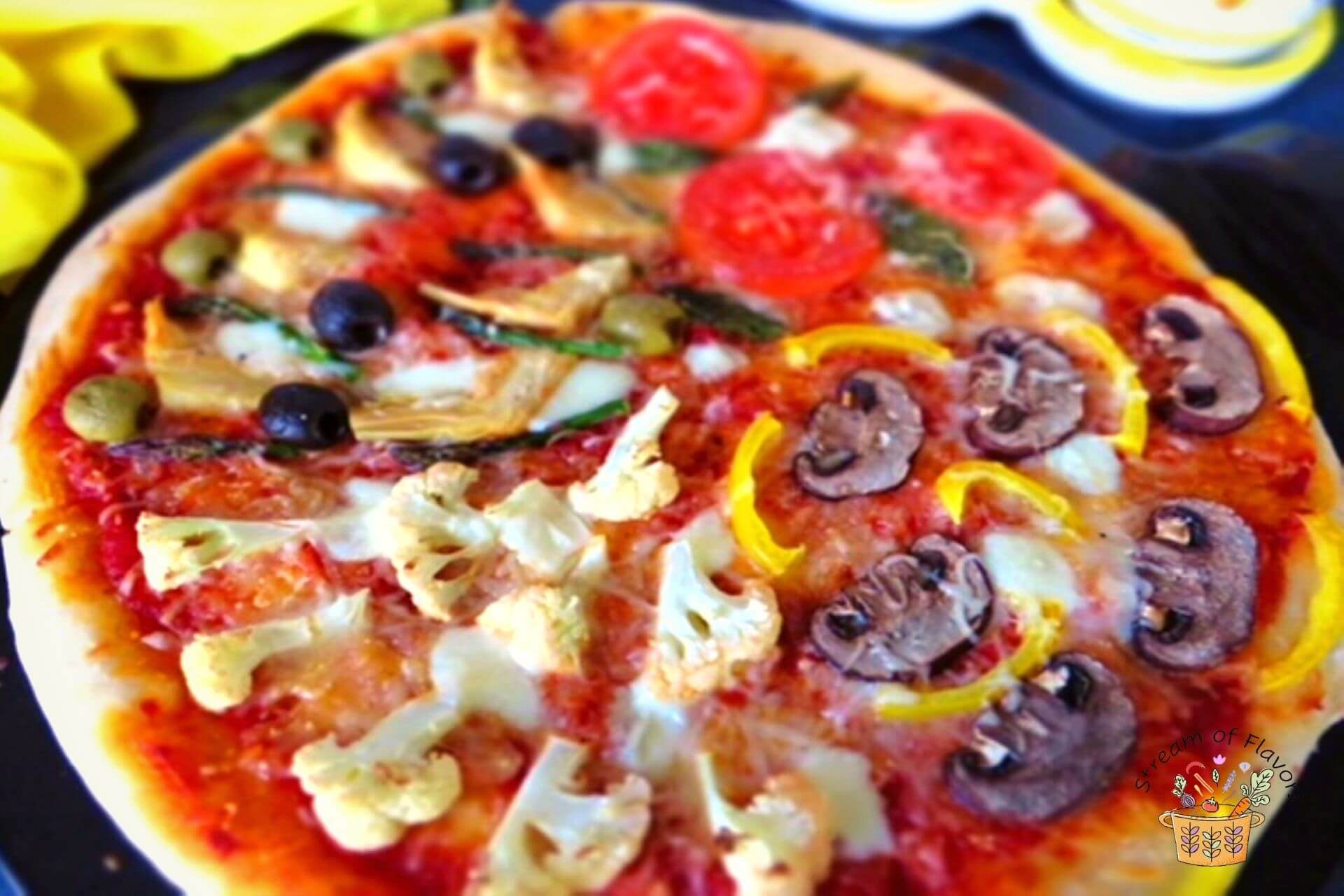
How to make the Four Seasons Pizza using my recipe:
- How to make the base:
- Dissolve the yeast and sugar in warm water. Add to the flour.
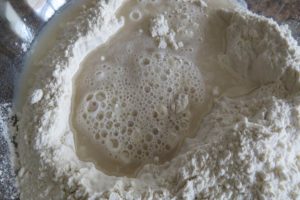
- Knead to a dough.
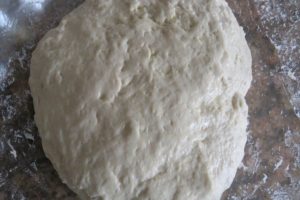
- Drizzle olive oil on top and cover with wet towel to rest for 1 hour. The dough would have risen or nearly doubled in bulk.

2. How to make the Four Seasons Pizza:
- Pre-heat the pizza stone for 5 minutes at 400oF. Remove the stone and spray with olive oil. Roll the dough to your desired thickness and place it carefully on the stone and pierce with a fork.
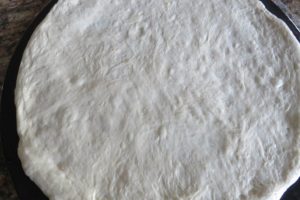
- Slice the vegetables.
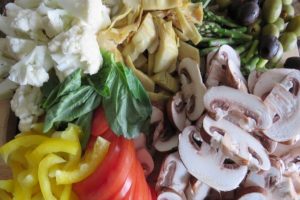
- Spread the marinara or pizza sauce on top.
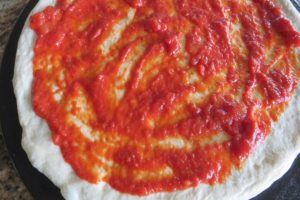
- Put some shredded cheese on top. Use a butter knife to mark four quarters. Put the corresponding veggies in each quarter to indicate the four seasons.
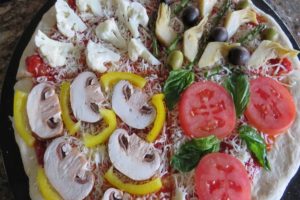
- Bake for 15 minutes. Remove the stone and add some fresh mozzarella and bake again at 425oF for 5 minutes.

1. The OO flour is traditionally used to make the Neopolitan pizzas. Using it to make the base takes the pizza to a whole new level, even if you do not have a wood-burning oven.
2. Pre-heating the stone for the pizza ensures that the pizza does not stick . I sprayed some olive oil before placing the base on it.
3. Some cooks use an inverted tray to slide the base on top of the stone. I rolled and lifted it onto the stone and then spread the sauce and toppings.
4. Keep everything sliced and ready to go as you have to be quick in placing the base and toppings on the hot stone.
5. I like to drain any juices from the tomato slices or bottled artichokes prior to placing them on the base, as they will otherwise make the base a bit soggy.
6. Re-baking the pizza for an additional 5 minutes with fresh Mozzarella cheese on top is an optional step. I like doing this because it gives the veggies an added crisp on the edges and melts the cheese just like we like it.
How to store the Four Seasons Pizza using my recipe:
Four Seasons Pizza using my recipe can be refrigerated for a couple of days or frozen for a couple of months in airtight containers. Thaw the pizza slices to room temperature and bake again in an oven on low settings until heated through for around 10 minutes.
Other Italian recipes to try:
Four Seasons Pizza Recipe
Equipment
- pizza stone, oven
Ingredients
For the pizza base:
- 1 cup OO flour
- 1 cup all-purpose flour
- ¾ tsp instant yeast
- 2 cup warm water
- a pinch sugar
- ½ tsp salt
- 1 tbsp olive oil extra virign
For the toppings:
- 1 cup artichokes and asparagus chopped
- 1 cup basil leaves, tomato and olive sliced
- 1 cup cauliflower floret sliced
- 1 cup mushroom and bell pepper sliced
- 1 cup Mozzarella cheese shredded
- ½ cup marinara or pizza sauce
Instructions
How to make the base:
- Dissolve the yeast and sugar in warm water. Add to the flour.
- Knead to a dough.
- Drizzle olive oil on top and cover with wet towel to rest for 1 hour. The dough would have risen or nearly doubled in bulk.
How to make the Four Seasons Pizza:
- Pre-heat the pizza stone for 5 minutes at 400oF. Remove the stone and spray with olive oil. Roll the dough and place it carefully on the stone and pierce with a fork.
- Slice the vegetables.
- Spread the marinara sauce on top.
- Put some shredded cheese on top. Use a butter knife to mark four quarters. Put the corresponding veggies in each quarter to indicate the four seasons.
- Bake for 15 minutes. Remove the stone and add some fresh mozzarella and bake again at 425oF for 5 minutes.
Notes
- You could substitute the OO flour with all-purpose flour, but there will be a difference in textures. (see blog post for more information)
- Feel free to vary the toppings per your preferences.
Nutrition


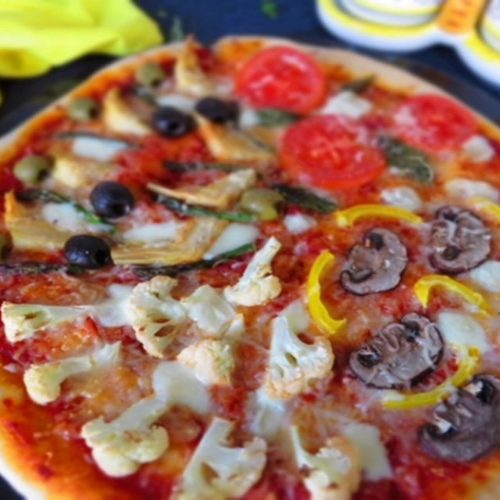






















Can’t wait to make this again!
Thanks!
So good!!
Thanks for the amazing recipe. Learning to cook after marriage, never had the time to cook before, hope I can cook for my husband.
You’re welcome, I’m glad you liked the recipe! Thanks.
i love this recipe!
i love how your post is so informative! thanks for sharing the history and the recipe!
You’re welcome. I’m glad you find it informative- thanks for the lovely comment!